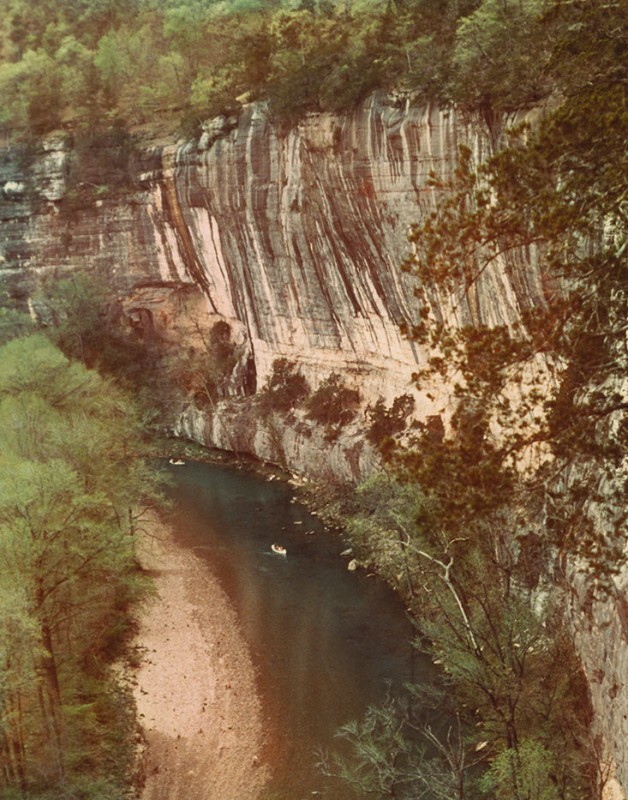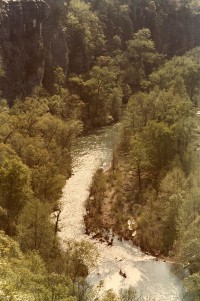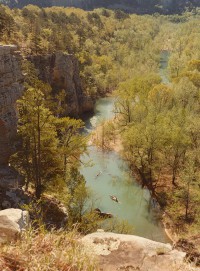Arkansas Heritage: The Buffalo National River Through the Lens of Ken Smith
Photographer and environmental activist Ken Smith hails from Hot Springs. He graduated from the University of Arkansas in 1956 with a bachelor’s degree in mechanical engineering. It was during his freshman year at the U of A that Smith first visited the Buffalo River with a hiking group.

Upon graduation, Smith took a job as an engineer for the paper mills at Crossett. During this time he first made photographs of and wrote about what would become, in part thanks to his efforts, the Buffalo National River.
In 1961, Smith left Arkansas and became an engineer and park planner for the National Park Service, which would take him many places. His engineering assignments were focused on management of park buildings, utility systems, roads and trails. Park planning often dealt with areas proposed as additions to the National Park system. Overall, his assignments took him to parks as large as Yosemite in California and as small as historic sites in Minnesota and Tennessee. Along the way, in 1967, he took part in planning for a proposed park for Arkansas: the Buffalo National River.
Meanwhile during those years, Smith’s friends in Arkansas were waging a campaign to protect the Buffalo River as a unit of the National Park system. To support those efforts, Smith took leave from the National Park Service to collect information and photographs for the 1967 book The Buffalo River Country to promote creation of the park.
After a 10-year campaign, the Buffalo National River was established in 1972.
Smith left the National Park Service in 1974 to settle in Fayetteville and become a freelance writer, photographer, researcher and environmentalist of the Ozarks, as well as a creator of hiking trails along the Buffalo National River. A life member of the Ozark Society, he served as education director of the environmental organization from 1974 to 1976 and has been an active member of other related organizations. Smith was featured in the 2008 award-winning film The Buffalo Flows: The Story of Our First National River, by U of A professor Larry Foley. In March 2017, Smith was inducted into the Arkansas Tourism Hall of Fame for his “tireless advocacy on behalf of the river, devoting countless hours to building trails and promoting conservation.”
The photos and maps in this exhibit show one result of Smith’s freelance activities.
His publications include:
The Buffalo River Country (Ozark Society, 1967); Illinois River: A People River (Ozark Society Foundation, 1977); Sawmill: The Story of Cutting the Last Great Virgin Forest East of the Rockies (University of Arkansas Press, 1986); Buffalo River Handbook (Ozark Society Foundation, 2004); and several reports and newspaper and magazine articles.
About University of Arkansas Libraries: Located at the heart of campus, David W. Mullins Library is the university’s main research library. Branch libraries include the Robert A. and Vivian Young Law Library, the Fine Arts Library, the Physics Library, and the Chemistry and Biochemistry Library. The Libraries provide access to more than 2 million volumes and 53,000 journals, and also offer individual and group research help, study spaces, computer labs with printing and scanning, interlibrary loan and RazorRush services, and cultural exhibits and events. The Libraries’ Special Collections unit acquires, preserves, and provides access to materials on Arkansas and the region, its customs and people, and its cultural, physical, and political climate. Visit the Libraries’ web page at libraries.uark.edu to learn more about services and collections.
About the University of Arkansas: The University of Arkansas provides an internationally competitive education for undergraduate and graduate students in more than 200 academic programs. The university contributes new knowledge, economic development, basic and applied research, and creative activity while also providing service to academic and professional disciplines. The Carnegie Foundation classifies the University of Arkansas among only 2 percent of universities in America that have the highest level of research activity. U.S. News & World Report ranks the University of Arkansas among its top American public research universities. Founded in 1871, the University of Arkansas comprises 10 colleges and schools and maintains a low student-to-faculty ratio that promotes personal attention and close mentoring.
(Click thumbnail image to enlarge.)




